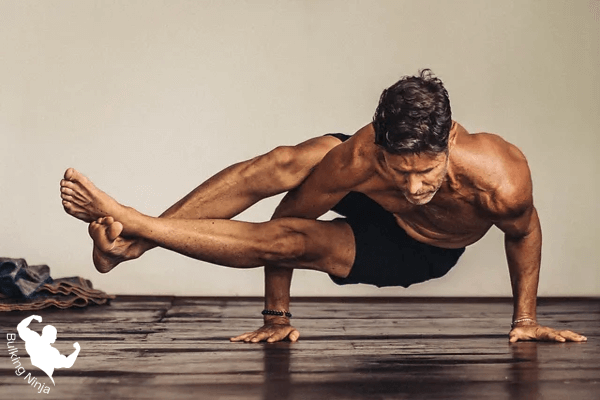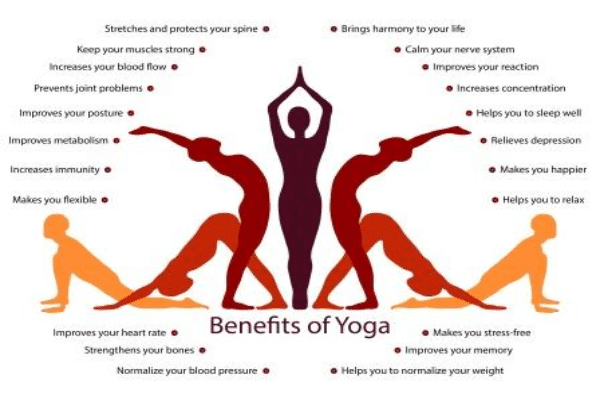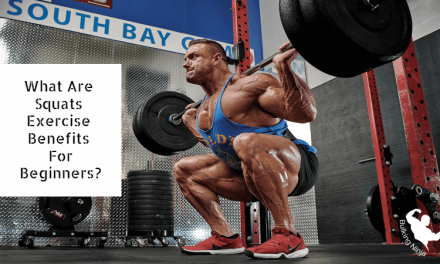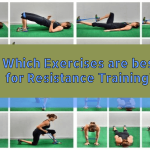Welcome to our latest blog post, where we’re about to embark on a journey that challenges some common misconceptions about yoga. While yoga is often associated with flexibility, relaxation, and mindfulness, it’s not typically thought of as a muscle-building activity.
However, in this article, we’re here to reveal the hidden potential of yoga when it comes to cultivating and strengthening muscles. Prepare to be surprised as we delve into the ways in which yoga can be a powerful tool for not only enhancing flexibility and mental well-being but also for sculpting a stronger, more resilient physique.
Whether you’re a seasoned yogi looking to take your practice to the next level or a fitness enthusiast seeking a new way to build muscle, this exploration of the intersection between yoga and muscle growth is sure to intrigue and inspire you.
Table of Contents
Yoga can grow muscles

In the realm of fitness, yoga stands out as an effective and holistic tool that complements traditional weight-training routines. Incorporating principles such as progressive overload, mechanical stress, and mechanical damage.
A dedicated yoga practice can indeed lead to an increase in muscular strength and improved lower-back flexibility, as evidenced by a 2015 study published in the Evidence-Based Complementary and Alternative Medicine journal.
While yoga primarily focuses on developing lean muscle and enhancing flexibility, it also has the potential to contribute to fat loss and improved muscle tone. The synergy between yoga and other forms of exercise, as suggested by the Physical Activity Guidelines for Americans, offers a pathway to achieving your fitness goals. Read more about sports are best for gaining muscles.
When combined, yoga becomes a popular and internal aspect of building strength, cultivating a lean body, and enhancing the potential for muscle development across various muscle groups.
How Does Yoga Build Muscle?

Yoga, often associated with flexibility and relaxation, may not seem like the most obvious choice for muscle building compared to traditional weightlifting or resistance training. However, it’s a common misconception that yoga cannot help in muscle growth. In fact, yoga can be an effective tool for building muscle in several ways:
- Body Weight Resistance
Many yoga poses and sequences require you to support and move your body weight, which effectively engages various muscle groups. Poses like plank, chaturanga, and warrior poses demand significant muscle activation, particularly in the arms, chest, shoulders, and core. - Isometric Contractions
Yoga involves holding poses for extended periods, which leads to isometric contractions where the muscles are engaged without changing in length. This sustained effort helps in building muscular endurance and strength. - Balanced Muscle Engagement
Unlike some traditional weightlifting exercises that isolate specific muscle groups, yoga promotes balanced muscle engagement. Most poses require multiple muscle groups to work together to maintain stability and alignment, leading to more comprehensive muscle development. - Functional Strength
Yoga emphasizes functional strength, meaning it enhances your ability to perform everyday activities with ease. It focuses on strengthening the muscles needed for daily movements like bending, twisting, and lifting, which can help prevent injuries. - Increased Blood Flow
Yoga incorporates controlled breathing techniques that enhance circulation and oxygen delivery to muscles. This improved blood flow aids in muscle recovery and growth. - Progressive Overload
Like in weightlifting, yoga principles, such as progressive overload, can be applied. As you advance in your practice, you can increase the intensity and duration of poses, gradually challenging your muscles to adapt and grow. - Mind-Muscle Connection
Yoga encourages a strong mind-muscle connection, promoting awareness of your body’s sensations and alignment. This heightened awareness can lead to better muscle control and development. - Enhanced Flexibility
While flexibility and muscle growth may seem unrelated, they are interconnected. Increased flexibility allows for a greater range of motion, which can lead to improved muscle recruitment and growth potential.
In summary, yoga can indeed contribute to muscle building when practiced consistently and with intention. While it may not lead to the same rapid muscle growth as traditional weightlifting, it offers a balanced and holistic approach to strengthening and toning muscles while providing various other physical and mental benefits. Incorporating yoga into your fitness routine can complement other forms of exercise and help you achieve a well-rounded and healthy physique.
How to do Yoga ?

Practicing yoga is a wonderful way to promote physical health, mental well-being, and relaxation. Here’s a step-by-step guide on how to do yoga:
Start with the Basics:
Find a quiet, comfortable space where you won’t be disturbed.
Wear comfortable clothing that allows for movement. Use a yoga mat or a non-slip surface to practice on.
Choose Your Style:
There are various styles of yoga, such as Hatha, Vinyasa, Ashtanga, Bikram, and more. Research and select a style that suits your goals and fitness level.
Warm-Up:
Begin with a gentle warm-up to prepare your body. You can start with deep breathing, neck rolls, and gentle stretches.
Learn Basic Poses:
Familiarize yourself with fundamental yoga poses like Mountain Pose (Tadasana), Downward-Facing Dog (Adho Mukha Svanasana), Child’s Pose (Balasana), and Cobra Pose (Bhujangasana). These poses form the foundation of many yoga sequences.
Practice Breathing:
Yoga places a strong emphasis on controlled breathing. Learn and practice different breathing techniques like Ujjayi (ocean breath), Pranayama (breath control), and deep diaphragmatic breathing.
Follow Online Tutorials or Classes:
If you’re new to yoga, consider following online tutorials or attending a beginner’s class at a local yoga studio. An experienced instructor can guide you through proper alignment and sequencing.
Set Intentions:
Before each practice, set an intention or focus for your session. This can be as simple as promoting relaxation, increasing flexibility, or building strength.
Sequence Your Poses:
Create a yoga sequence or flow that aligns with your intentions. There are many pre-designed sequences available online or in yoga books, or you can work with an instructor to create a personalized routine.
Pay Attention to Alignment:
Focus on proper alignment in each pose to prevent injury and maximize the benefits. Listen to your body and make adjustments as needed.
Gradually Progress:
Yoga is about continuous improvement. As you gain experience and flexibility, you can explore more advanced poses and sequences.
Cool Down and Relaxation:
End your practice with a cool-down period that includes gentle stretches and relaxation poses like Savasana (Corpse Pose). This helps your body and mind transition out of the practice.
Practice Regularly:
Consistency is key in yoga. Aim to practice regularly, even if it’s just for a few minutes each day. Over time, you’ll notice improvements in flexibility, strength, and mental clarity.
Respect Your Limits:
Yoga is a personal journey, and it’s essential to respect your body’s limits. Avoid pushing yourself too hard, especially if you’re a beginner or dealing with injuries.
Listen to Your Body:
Always listen to your body. If a pose causes pain or discomfort beyond the usual stretch, modify or skip it. Consult a healthcare professional if you have any concerns.
Remember that yoga is not just about physical postures; it’s also a practice that fosters mindfulness and inner peace. Embrace the journey, and enjoy the physical and mental benefits that yoga can offer.
What Are the Health Benefits Of Yoga?

Yoga offers a wide range of physical, mental, and emotional health benefits. Regular practice can have a profound positive impact on your overall well-being. Here are some of the key health benefits of yoga:
- Improved Flexibility: Yoga involves a variety of poses and stretches that can gradually increase your flexibility by targeting different muscle groups and joints. Increased flexibility can lead to better posture and reduced risk of injury.
- Enhanced Strength: Many yoga poses require you to support your body weight, which builds strength in various muscle groups, including the core, arms, legs, and back.
- Better Posture: Yoga promotes awareness of body alignment and helps improve posture. This can reduce strain on the spine and muscles, alleviating back and neck pain.
- Stress Reduction: Yoga incorporates mindfulness and relaxation techniques, including deep breathing and meditation, which can reduce stress and promote a sense of calm and relaxation.
- Mental Clarity: Regular yoga practice can enhance mental clarity, concentration, and focus. It encourages mindfulness and the ability to stay present in the moment.
- Pain Management: Yoga can be an effective complementary approach to managing chronic pain conditions, such as lower back pain, arthritis, and migraines. It helps increase body awareness and reduce pain perception.
- Better Sleep: Yoga’s relaxation techniques can improve sleep quality and help those with insomnia or other sleep disorders.
- Improved Balance: Yoga poses that challenge balance can enhance stability and coordination. This is particularly beneficial as you age to reduce the risk of falls.
- Cardiovascular Health: Certain types of yoga, such as Vinyasa or Power Yoga, involve dynamic movements that can contribute to cardiovascular fitness and lower the risk of heart disease.
- Weight Management: While not as intense as some forms of exercise, regular yoga practice can aid in weight management by increasing awareness of eating habits and promoting mindfulness.
- Digestive Health: Yoga postures and breathing exercises can stimulate digestion and alleviate digestive issues like constipation and irritable bowel syndrome (IBS).
- Immune System Support: Stress reduction and improved circulation associated with yoga can boost the immune system, making you less susceptible to illness.
- Emotional Well-Being: Yoga encourages self-acceptance and self-compassion, which can improve overall emotional well-being and reduce symptoms of anxiety and depression.
- Increased Energy: Practicing yoga can increase overall energy levels and reduce feelings of fatigue.
- Better Respiratory Function: Yogic breathing exercises (Pranayama) can enhance lung capacity, improve respiratory function, and reduce symptoms of respiratory conditions like asthma.
It’s important to note that the specific benefits you experience may vary depending on the type of yoga you practice and your individual goals and needs. To maximize the health benefits of yoga, consider finding a style and routine that aligns with your objectives and consulting with a qualified yoga instructor or healthcare professional if you have specific health concerns.
Can Yoga Replace ‘Traditional’ Strength Training?
Yoga and traditional strength training are both valuable forms of exercise, but they serve different purposes and can complement each other rather than replace one another. Whether yoga can replace traditional strength training depends on your fitness goals and individual preferences. Here are some key points to consider:
- Different Focus:
- Yoga primarily emphasizes flexibility, balance, and body awareness, while traditional strength training focuses on building muscle mass and increasing overall strength.
- Muscle Development:
- While yoga can help develop lean muscle, it may not provide the same level of muscle hypertrophy (increase in muscle size) as traditional strength training, which often involves lifting heavier weights.
- Cardiovascular Fitness:
- Traditional strength training doesn’t typically provide the cardiovascular benefits that certain types of yoga, like Vinyasa or Power Yoga, can offer. These yoga styles incorporate dynamic movements that elevate the heart rate.
- Weight Loss:
- If weight loss is a primary goal, traditional strength training combined with cardiovascular exercise (e.g., running or cycling) may be more effective than yoga alone.
- Core Strength:
- Yoga is excellent for core strength and stability, but traditional strength training can also target the core with specific exercises like planks and crunches.
- Mind-Body Connection:
- Yoga places a strong emphasis on the mind-body connection, mindfulness, and relaxation. This aspect is not typically a focus of traditional strength training.
- Injury Prevention and Rehabilitation:
- Yoga can be beneficial for injury prevention, rehabilitation, and improving flexibility, making it a useful addition to a traditional strength training regimen.
- Personal Goals:
- Your specific fitness goals will determine whether yoga can replace traditional strength training. If you aim to build significant muscle mass and increase maximum strength, traditional strength training will likely be more effective.
- Complementary Approach:
- Many individuals choose to combine yoga with traditional strength training to create a well-rounded fitness routine. Yoga can help improve flexibility, reduce the risk of injury, and enhance overall body awareness, which can enhance the effectiveness of strength training.
In short Words yoga and traditional strength training serve different purposes, and whether yoga can replace strength training depends on your goals. If your primary objective is muscle building and increasing maximal strength, traditional strength training remains essential. However, yoga can be a valuable and complementary addition to your fitness routine, offering benefits in flexibility, balance, injury prevention, and overall well-being. Ultimately, the ideal approach may involve integrating both practices to achieve a balanced and holistic fitness regimen.
Frequently asked Questions
Can daily yoga Build muscle?
Daily yoga can build lean muscle and enhance muscle tone, but it may not lead to significant muscle mass gains like traditional strength training.
Does yoga change your muscles?
Yes, yoga can change and strengthen your muscles by increasing flexibility, tone, and overall strength.
How long does yoga take for muscles?
The time it takes to see noticeable changes in your muscles from yoga varies depending on factors like frequency, intensity, and individual differences. Generally, you may start to feel and see improvements in flexibility and muscle tone within a few weeks of consistent practice. Significant muscle growth may take several months or more.
What does yoga do to your muscles?
Yoga improves muscle strength, flexibility, endurance, and balance. It enhances posture, reduces stress, and can prevent injuries by promoting muscle relaxation and coordination through various poses and deep breathing techniques.
Why gym is better than yoga?
The preference for the gym over yoga or vice versa depends on individual goals. Gyms are favored for muscle building, cardiovascular fitness, variety, and social interaction. Yoga offers benefits like flexibility, balance, stress reduction, and holistic wellness. The choice should align with your specific fitness goals and preferences. Many people find a balanced approach that includes elements of both gym workouts and yoga to be ideal.
Is yoga enough of a workout?
Yoga can provide a workout that contributes to overall health and well-being, focusing on flexibility, balance, and stress reduction. However, whether yoga is enough of a workout depends on your fitness goals. If your primary goal is building significant muscle mass or intense cardiovascular conditioning, you may need to complement your yoga practice with other forms of exercise. Yoga can be an essential part of a well-rounded fitness routine but may not meet all fitness objectives on its own.
Is yoga more beneficial than exercise?
The relative benefit of yoga versus traditional exercise depends on your goals. Yoga emphasizes mind-body connection, flexibility, and balance while promoting relaxation. Traditional exercise, like cardio and strength training, is better for building muscle, improving cardiovascular fitness, and aiding in weight loss. The choice should align with your specific objectives. Many people find a combination of both yoga and traditional exercise to be the most balanced approach for overall fitness.
Can you build muscle with yoga?
Certainly! Yoga can build muscle through:
- Isometric Strength: Holding poses like Plank or Warrior builds strength.
- Range of Motion: Enhances stability and effectiveness in strength training.
- Core Strength: Many yoga poses strengthen the core muscles.
- High Repetition Movements: Repeating certain poses can lead to muscle growth.
- Balance and Symmetry: Corrects imbalances and promotes overall muscular development.
How do yoga muscle gain?
Conclusion
In conclusion, yoga can indeed play a valuable role in promoting muscle growth. While it may not provide the same level of muscle development as intensive weightlifting or resistance training, it offers a holistic approach to fitness that encompasses strength, flexibility, balance, and mindfulness.
By incorporating yoga into your fitness routine, you can enhance your overall physical well-being, support muscle maintenance and flexibility, and enjoy the mental and emotional benefits that come with it.
The key lies in finding the right balance that aligns with your specific fitness goals and preferences. Whether you’re a seasoned yogi or new to the practice, yoga’s potential to foster muscle growth makes it a valuable addition to any fitness journey.














